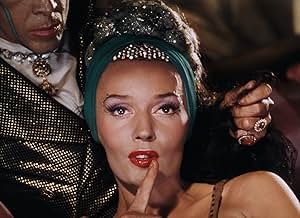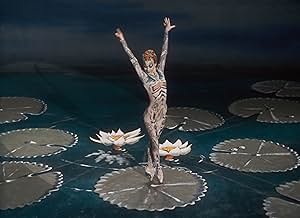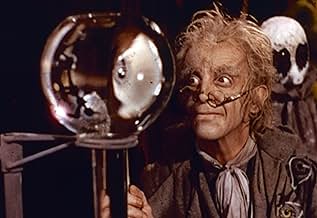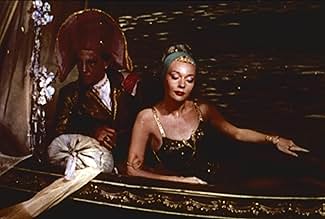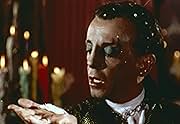Un poète mélancolique repense aux trois femmes qu'il a aimées et perdues dans sa vie? une poupée mécanique, une courtisane vénitienne et la fille tuberculeuse d'un célèbre compositeur.Un poète mélancolique repense aux trois femmes qu'il a aimées et perdues dans sa vie? une poupée mécanique, une courtisane vénitienne et la fille tuberculeuse d'un célèbre compositeur.Un poète mélancolique repense aux trois femmes qu'il a aimées et perdues dans sa vie? une poupée mécanique, une courtisane vénitienne et la fille tuberculeuse d'un célèbre compositeur.
- Nommé pour 2 oscars
- 2 victoires et 3 nominations au total
- Giulietta
- (as Ludmilla Tcherina)
- …
- Spalanzani
- (as Leonide Massine)
- …
- Olympia
- (singing voice)
- …
- Giulietta
- (singing voice)
- …
- Nicklaus
- (singing voice)
- …
- Antonia's Mother
- (singing voice)
- Spalanzani
- (singing voice)
- …
Avis en vedette
In "The Tales of Hoffmann", Robert Rounsevill stars as E.T.A. (Ernst Theodore Amadeus) Hoffmann, the poet and writer who tells three stories of his great but unhappy loves all ending tragically thanks to the meddling of his enemy, a supernatural villain (Robert Helpmann as quadruple evil, Lindorf, Coppelius, Dapertutto and Dr Miracle). Objects of Hoffmann's love and admiration include Olympia the wind-up doll (Moira Shearer who also plays Stella the dancer, the fourth and yet another Hoffmann's misadventure), Giulietta, the Venetian courtesan who sails away after trying to capture Hoffmann's soul (Ludmilla Tchérina -absolutely brilliant as the siren and the seductress who elegantly walks over the dead bodies, literally), and Antonia the beautiful opera-singer with the fatal voice and deadly illness. One of the greatest choreographers and dancers of the last century, Léonide Massine shines in three absolutely different roles demonstrating his talent as a dancer, strong emotions and tremendous humor.
What makes "The Tales of Hoffmann" not just an ordinary screen adaptation but the stunning unforgettable event, the film which had inspired the future famous directors George Romero and Martin Scorsese to become the filmmakers is the perfect combination of fantasy, classical music, ballet, singing, stunning visual effects, imaginative and often bizarre and even disturbing images that would fit a horror movie (deconstructing Olympia the doll is horrifying), incredible but calculated feast of colors, their mixture, the unique color palette to match each story, camera work that is so innovative and dynamic that even now, 56 years after the film was made, looks fresh and modern. The feast for eyes, ears, and feelings, "The Tales of Hoffmann" is the love child of incredibly talented people from different epochs and countries. The opera by Jacques Offenbach, the French composer is based on the dark romantic fairy tales by the German E.T. A. Hoffmann. The team of two directors known as "The Archers", the British Michael Powell and the Hungarian Jew Emeric Pressburger who had to flee his country before the WWII, and their international team of stars, color consultants, choreographers and production designers made this miracle happen. The last but not the least is legendary Sir Thomas Beecham conducting the Royal Philharmonic Orchestra.
On first viewing, my reaction to it was mixed: it's impossible not to be impressed by the visuals (particularly the stylization of Hein Heckroth's colorful and imaginative designs) but, since I'm no expert in classical music, I wasn't bowled over by Jacques Offenbach's score (apart from the celebrated "Barcarolle" piece) - especially since the lyrics, despite being an English translation, aren't easily followed! However, listening to it with the Audio Commentary, I could better appreciate the way it was made and the special effects that were adopted; especially interesting was the fact that it was filmed silent, thus allowing freer camera movement. The main cast, apart from Pamela Brown, is made up of ballet performers and opera singers - with the former, mostly recruits from THE RED SHOES, carrying the more compelling screen presence.
The framing story - featuring an additional ballet composed by the film's conductor Sir Thomas Beecham - is a bit short, so that we mostly learn about the characters played by Robert Rounseville (as Hoffmann) and Robert Helpmann through their various guises in the former's three tales (which are themselves variable in quality):
i) the "Olympia" sequence, highlighting Moira Shearer and Leonide Massine, is overlong but quite charming; Helpmann's distinctive features are rather buried under some quaint make-up - though his violent destruction of Shearer (who plays a doll) makes for a quite unsettling moment!
ii) "Giulietta" is the best and most interesting sequence, but also the shortest: Ludmilla Tcherina is a very sensuous heroine, while Helpmann and Massine are wonderful (and wonderfully made up) as respectively an evil magician and a (literally) soulless officer under both their spell; this sequence features some incredible imagery - like Tcherina's reflection in water picking up the aria she is singing, her walking over sculptures of dead bodies, Rounseville and Massine's saber duel set to music (i.e. presented without any sound effects) and the scene in which Rounseville loses his reflection when tempted in front of a mirror by Tcherina
iii) the "Antonia" sequence is again too long (it was severely cut in the original U.S. theatrical release) and, because it's mostly straight opera, emerges as the most labored segment: Massine is pretty much wasted here, while Ann Ayars is nowhere near as captivating as Shearer or Tcherina; however, Helpmann's belated entrance as the satanic Dr. Miracle takes the sequence to another level, and especially memorable here is the scene where Ayars exits a room only to re-enter it from another door (which must have inspired a similar incident in Mario Bava's KILL, BABY, KILL! [1966]) and the one where Ayars and Helpmann's dancing figures are divided into four to fill up the entire screen - with the latter taking each of his guises in the different segments and, likewise, the former being replaced with the heroines of each tale (Moira Shearer appears twice here as she also plays Stella, Hoffmann's love interest in the framing story!)
The Archers' films are among my favorites - though I was somewhat underwhelmed by I KNOW WHERE I'M GOING! (1945; I still haven't purchased the Criterion SE), THE BATTLE OF THE RIVER PLATE (1956; amazingly, both of my two attempts to view it in the past have only managed to put me to sleep!) and, now, THE TALES OF HOFFMANN. I've yet to watch 4 of their collaborations - CONTRABAND (1940; I've been tempted, time and again, to buy Kino's bare-bones DVD but the over-inflated price always got in the way!), THE ELUSIVE PIMPERNEL (1950), GONE TO EARTH (1950; this troubled production isn't likely to see the light of day on R1 DVD anytime soon, but is at least available via a budget-priced R2 edition), and their last 'musical' together OH, ROSALINDA! (1955). I would also like to watch Powell's solo films HONEYMOON (1959) and BLUEBEARD'S CASTLE (1964), which are yet two more musically-oriented ventures.
With the audacity that Powell & Pressburger were famous for we are presented with a wonderful performance of a truly "composed" film. All the soundtrack was recorded by Sir Thomas Beecham and the Royal Philharmonic Orchestra and then the filming was all done on the open stage (it didn't need a sound stage) at Shepperton.
With choreography by Sir Frederick Ashton and performances by ballet luminaries such as Moira Shearer, Ludmilla Tchérina, Robert Helpmann, Léonide Massine and Sir Frederick Ashton himself. Assisted by opera stars such as Robert Rounseville and Anne Ayars and the Sadler's Wells Chorus. All this backed by the designs of Hein Heckroth and the experienced team of technicians that worked regularly under the banner of The Archers leads to a treat to behold.
The plot - from a 1951 (year of release) programme.
The Prologue : The Opera House in Nurnberg (Nüemburg). Hoffmann sits in the auditorium watching a performance of the Dragonfly ballet. He is in love with Stella, the prima ballerina, who seems the embodiment of all his past loves. In the interval Hoffmann goes to Luther's Tavern. Here young students greet him. He sings them the ballad of Kleinzack. But the sight of Stella has reopened old wounds. "Would YOU hear the three tales of my folly of love?" lie asks. The students gather round the punch bowl, with Hoffmann's companion, Nicklaus, who has accompanied him throughout his adventures, and his enemy Lindorf.
The Tale Of Olympia : As an inexperienced student in Paris, Hoffmann was tricked by two puppet-makers, Spalanzani and Coppelius, into falling in love with their latest creation, the doll Olympia. Spalanzani passes Olympia off as his daughter and hopes by this means to get some money from Hoffmann. At a ball given for her, Olympia sings the "Doll Song" and dances a ballet. Hoffmann is entranced. Only when Spalanzani and Coppelius fall out, and Coppelius destroys the doll in revenge does Hoffmann realise how he was fooled.
The Tale Of Giulietta : As a young man of the world, he was enslaved by a beautiful Venetian courtesan, Giulietta. Acting under the influence of the magician Dapertutto, Giulietta captures his reflection and so gains possession of his soul. Hoffmann kills her former lover Schlemil in a duel, to get the key to her room. He hurries back to her, but finds she has left with Dapertutto. Mad with rage, he flings the key against her mirror. It cracks, and his reflection reappears. He has regained his soul.
The Tale Of Antonia : As a mature artist and poet, Hoffmann falls in love with Antonia. Her mother, a singer, has already died of consumption (Tuberculosis). Crespel, her father, through grief at his wife's death, is now the half-mad wreck of a formerly great conductor. Crespel keeps his daughter in seclusion on an island in the Greek Archipelago and forbids her to aggravate her own weakness by singing. He also forbids his deaf servant Franz to admit either Hoffmann or the quack Dr. Miracle who killed his wife. Franz misunderstands, and in turn shows them in. Hoffmann realises Antonia is ill, and she promises him not to sing again. Dr. Miracle persuades her it is her mother's wish she should disobey. She does so, and dies in his arms.
The Epilogue : On the stage of the Opera House, it is the finale of the Stella Ballet. In the tavern Hoffmann's audience is spellbound. Hoffmann's tales are told and with the telling Hoffmann finds his true destiny as a poet. Stella appears at the door of the tavern and looks down at him. But Lindorf, who has also understood the meaning of the Tales goes to meet her and together they pass out into the town.
Le saviez-vous
- AnecdotesGeorge A. Romero, writer/director of La nuit des morts vivants (1968) and L'aube des morts (1978) has cited this as his all-time favorite movie, saying that it was the one that originally inspired him to get into filmmaking.
- GaffesGiulietta's necklace is turned from jewels to wax by Dapertutto, however, in a longer shot, it is briefly shown as jewels again, before a close-up, where it is wax again until Dapertutto changes it back to jewels.
- Citations
Chorus of Students: Some drink, drink, drink, drink, drink: do you hear us about? You lazy lout! We want some beer; we want some wine! Pour out the wine, and drink and drink till morning. Pour out the wine for drinking is divine. It is divine. We want some beer; we want some wine. We want some beer; we want some wine.
- Générique farfeluIn the end credits, main actors appear taking curtain calls next to the singers who dubbed them.
- Autres versionsThe complete 138-minute version was available in 16mm black and white early television prints. The complete 138-minute version was also available in 16mm Kodachrome (color) rental prints. The complete 138-minute soundtrack was available for many years on LP (London Records).
- ConnexionsFeatured in The Late Show: Michael Powell (1992)
- Bandes originalesThe Tales of Hoffmann, A Fantastic Opera
Music by Jacques Offenbach
Arranged by Thomas Beecham (uncredited)
English libretto by Dennis Arundell
From the French text by Jules Barbier
Conductor: Thomas Beecham (as Sir Thomas Beecham Bart.) with The Royal Philharmonic Orchestra
Sung by Robert Rounseville, Dorothy Bond, Margherita Grandi, Ann Ayars (as Ann Ayars), Monica Sinclair, Joan Alexander, Grahame Clifford, Bruce Dargavel, Murray Dickie, Owen Brannigan, Fisher Morgan, Rene Soames, and The Sadler's Wells Chorus
Meilleurs choix
Détails
- Date de sortie
- Pays d’origine
- Langue
- Aussi connu sous le nom de
- Los cuentos de Hoffman
- Lieux de tournage
- sociétés de production
- Consultez plus de crédits d'entreprise sur IMDbPro
Box-office
- Brut – États-Unis et Canada
- 91 930 $ US
- Fin de semaine d'ouverture – États-Unis et Canada
- 23 340 $ US
- 15 mars 2015
- Brut – à l'échelle mondiale
- 140 714 $ US
- Durée
- 2h 13m(133 min)
- Rapport de forme
- 1.37 : 1




